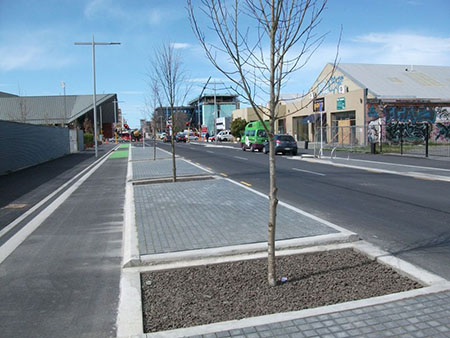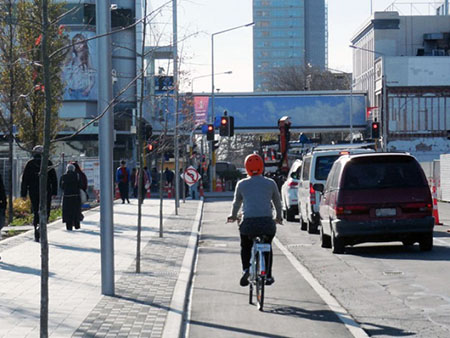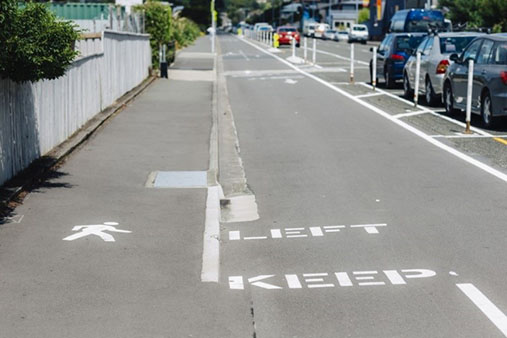Cycle paths are intended for the exclusive use of cyclists and are therefore different to shared paths which are also intended for use by pedestrians. However, the TCD rule defines a cycle path as
part of the road that is physically separated from the roadway that is intended for the use of cyclists, but which may be used also by pedestrians.
As per the Cycle Network and Route Planning Guide, the term ‘cycle path’ may also refer to a facility that is not adjacent to a road and therefore covers a route not provided as part of the road network. They may therefore be used to offer cyclists some advantage over motorists, for example, by providing a cycle route through a park giving cyclists a shorter route than what is available using the road network.
Cycle paths are physically separated from the roadway and are intended for the use of cyclists but may be used also by pedestrians. The separation may involve horizontal and / or vertical components.
Under New Zealand traffic law, as cycle paths physically exclude general traffic, they are not considered to be ‘roadway’. This means that at intersections, cyclists using cycle paths enter the roadway and are required to give way to all vehicles, which can be contrary to road user expectations.
Watch this space, an update will be coming.
The term cycle path incorporates facilities known as: ‘protected cycle lanes’ (Auckland Transport), ‘separated cycle lanes’ (Christchurch City Council), ‘separated bicycle lanes’ (Austroads), ‘buffered bicycle lanes’ (Queensland Transport and Main Roads), and ‘cycle tracks’ (NACTO). However, in the TCD manual the term cycle path is used exclusively.
Guidance for cycle paths can be found in the Cycling Network Guidance, where they are described as ‘separated cycleways’.
Cycle paths can be either:
There is a range of methods that can be employed to separate and protect cyclists from motor traffic, each offering different levels of actual safety (ie in terms of crash risk) and perceived safety (ie in terms of people’s subjective evaluations). Some examples of recently developed cycle paths (referred to as separated cycleways in Waka Kotahi Cycle Network Guidance) in New Zealand are shown in Figure 8‑13.
Figure 8‑13: Examples of cycle paths in New Zealand, clockwise from top left: Tuam Street, Christchurch (Jeanette Ward); Colombo Street, Christchurch (Jeanette Ward); Beach Road, Auckland; St Vincent Street, Nelson




Devices that can be used to provide separation for cycle paths can be found in the cycleway separation device selection matrix.
Cycleway separation device selection matrix [PDF, 652 KB]
Selection of the most appropriate device(s) for cycle paths will depend on the factors described in the Cycling Network Guidance: Choice of separator or protection.
Cycling Network Guidance: Choice of separator or protection
Intermittent separation refers to the use of physical objects intermittently placed alongside, or on top of a cycle path marking to help better segregate the cycle facility from motorised traffic in constrained environments, in locations where full physical segregation may create issues or as a temporary improvement to an on-road cycle path.
While there are many international examples, there is little established practice in New Zealand. This combination has led to a variety of interventions with differing degrees of success.
Intermittent separation using posts creates a variant of normal marked cycle lanes, offering some of the benefits of full separation in terms of feeling of safety. In all cases, it is important to follow guidance on recommended widths of cycle lanes given that cycle safety and comfort cannot readily be improved if motor traffic is passing a narrow cycle lane with little clearance. It is also important to recognise that the installation of any physical device to create separation narrows the effective width of any facility by creating a natural riding line with cyclists shying away from physical objects.
In comparison to lane markings only, users feel safer when intermittent separation devices are placed next to the marking. Cyclists stay further from lower separating objects but are more comfortable riding nearer to moving motor vehicles where they are separated by high objects such as flexible posts. This is an important consideration for the effective width of the cycle lane and the potential for overtaking within the lane.
Devices that can be used to provide intermittent separation for cycle paths can be found in the cycleway separation device selection matrix.
Cycleway separation device selection matrix [PDF, 652 KB]
Selection of the most appropriate device(s) for intermittent separation of cycle paths will depend on the factors described in the Cycling Network Guidance: Choice of separator or protection.
Cycling Network Guidance: Choice of separator or protection
Whatever object is used for intermittent separation, it should not resemble an existing road marking or obstruct a road marking in a way that might make it unidentifiable.
Intermittent separation devices will need maintaining and, very often, will need replacing when damaged. In all cases, it is important to follow manufacturers’ instructions on installation, particularly with regard to fixing to the roadway surface, to ensure the product performs as it should and does not fail when struck.
Currently, very few signs have been designated specifically for use on cycle paths; where cycle path signs for a given purpose are not available, the signs and markings for on-road cycle lanes should be used. Refer to cycle lane markings and delineation and cycle signs for information regarding these signs and markings.